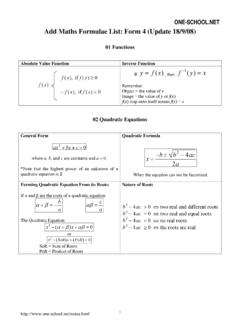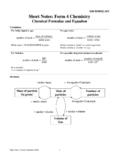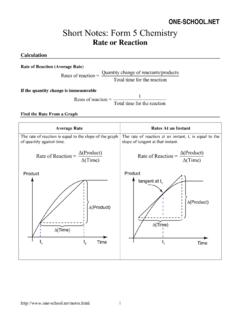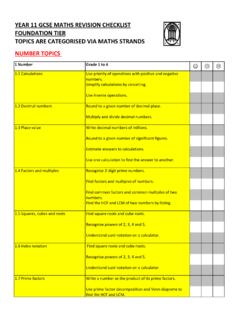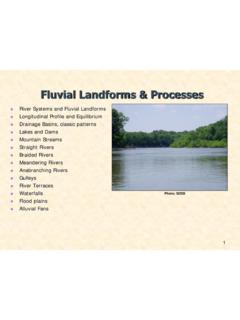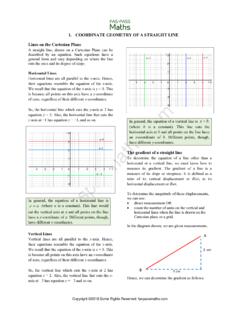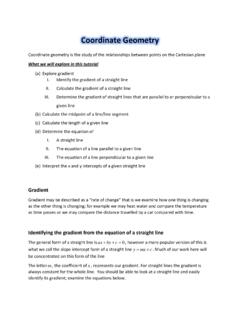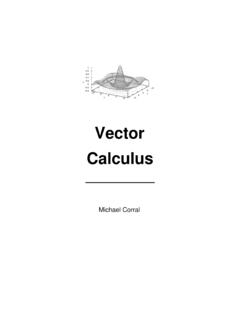Transcription of ONE-SCHOOL.NET Physics Equation List :Form 4
1 1 Physics Equation List :Form 4 Introduction to Physics Relative Deviation Mean DeviationRelative Deviation = 100%Mean Value Prefixes Prefixes Value Standard form Symbol Tera 1 000 000 000 000 1012 T Giga 1 000 000 000 109 G Mega 1 000 000 106 M Kilo 1 000 103 k deci 10-1 d centi 10-2 c milli 10-3 m micro 001 10-6 nano 000 001 10-9
2 N pico 000 000 001 10-12 p Units for Area and Volume 1 m = 102 cm (100 cm) 1 m2 = 104 cm2 (10,000 cm2) 1 m3 = 106 cm3 (1,000,000 cm3) 1 cm = 10-2 m (1100m) 1 cm2 = 10-4 m2 (2110, 000m) 1 cm3 = 10-6 m3 (311, 000, 000m) 2 Force and Motion Average Speed Total DistanceAverage SpeedTotal Time= Velocity svt= v = velocity (ms-1) s = displacement (m) t = time (s) Acceleration vuat = a = acceleration (ms-2) v = final velocity (ms-1) u = initial velocity (ms-1) t =time for the velocity change (s) Equation of Linear Motion Linear MotionMotion with constant velocityMotion with constant accelerationMotion with changing acceleration svt=atuv+=tvus)(21+=221atuts+=asuv222+=U sing Calculus(In Additional Mathematics Syllabus) u = initial velocity (ms-1) v = final velocity (ms-1) a = acceleration (ms-2) s = displacement (m) t = time (s) 3 Ticker Tape Finding Velocity: velocitynumber of ticks 1 tick = Finding Acceleration: vuat = a = acceleration (ms-2) v = final velocity (ms-1) u = initial velocity (ms-1) t = time for the velocity change (s) Graph of Motion Gradient of a Graph The gradient 'm' of a line segment between two points and is defined as follows.
3 Change in y coordinate, Gradient, Change in x coordinate, ymxorymx = = 4 Displacement-Time Graph Velocity-Time Graph Gradient = Velocity (ms-1) Gradient = Acceleration (ms-2) Area in between the graph and x-axis = Displacement Momentum pmv= p = momentum (kg ms-1) m = mass (kg) v = velocity (ms-1) Principle of Conservation of Momentum 112 2112 2mum umvm v+=+ m1 = mass of object 1 (kg) m2 = mass of object 2 (kg) u1 = initial velocity of object 1 (ms-1) u2 = initial velocity of object 2 (ms-1) v1 = final velocity of object 1 (ms-1) v2 = final velocity of object 2 (ms-1) Newton s Law of Motion Newton s First Law In the absence of external forces, an object at rest remains at rest and an object in motion continues in motion with a constant velocity (that is, with a constant speed in a straight line).
4 5 Newton s Second Law mv muFt Fma= The rate of change of momentum of a body is directly proportional to the resultant force acting on the body and is in the same direction. F = Net Force (N or kgms-2) m = mass (kg) a = acceleration (ms-2) Implication When there is resultant force acting on an object, the object will accelerate (moving faster, moving slower or change direction). Newton s Third Law Newton's third law of motion states that for every force, there is a reaction force with the same magnitude but in the opposite direction. Impulse ImpulseFt= Impulsemv mu= F = force (N) t = time (s) m = mass (kg) v = final velocity (ms-1) u = initial velocity (ms-1) Impulsive Force mv muFt = F = Force (N or kgms-2) t = time (s) m = mass (kg) v = final velocity (ms-1) u = initial velocity (ms-1) Gravitational Field Strength Fgm= g = gravitational field strength (N kg-1) F = gravitational force (N or kgms-2) m = mass (kg) Weight Wmg= W = Weight (N or kgms-2) m = mass (kg) g = gravitational field strength/gravitational acceleration (ms-2) 6 Vertical Motion If an object is release from a high position: The initial velocity, u = 0.
5 The acceleration of the object = gravitational acceleration = 10ms-2(or ms-2). The displacement of the object when it reach the ground = the height of the original position, h. If an object is launched vertically upward: The velocity at the maximum height, v = 0. The deceleration of the object = -gravitational acceleration = -10ms-2(or ms-2). The displacement of the object when it reach the ground = the height of the original position, h. Lift In Stationary Rmg= When a man standing inside an elevator, there are two forces acting on him. (a) His weight which acting downward. (b) Normal reaction (R), acting in the opposite direction of weight. The reading of the balance is equal to the normal reaction. 7 Moving Upward with positive acceleration Moving downward with positive acceleration Rmgma=+ Rmgma= Moving Upward with constant velocity Moving downward with constant velocity.
6 Rmg= Rmg= Moving Upward with negative acceleration Moving downward with negative acceleration Rmgma= Rmgma=+ 8 Smooth Pulley With 1 Load T1 = T2 Moving with uniform speed: T1 = mg Stationary: T1 = mg Accelerating: T1 mg = ma With 2 Loads Finding Acceleration: (If m2 > m1) m2g m1g = (m1+ m2)a Finding Tension: (If m2 > m1) T1 = T2 T1 m1g = ma m2g T2 = ma Vector Vector Addition (Perpendicular Vector) Magnitude = 22xy+ Direction = 1||tan||yx Vector Resolution ||| |sinxp = ||| |cosyp = 9 Inclined Plane Component parallel to the plane = mgsin Component perpendicular to the plane = mgcos Forces In Equilibrium 3 Tmg= 2sinTmg = 21cosTT = 1tanTmg = 3 Tmg= 21coscosTT = 21sinsinTT mg += Work Done cosWFx = W = Work Done (J or Nm) F = Force (N or kgms-2) x = displacement (m) = angle between the force and the direction of motion (o) When the force and motion are in the same direction.
7 WFs= W = Work Done (J or Nm) F = Force (N or kgms-2) s = displacement (m) 10 Energy Kinetic Energy 212 KEmv= EK = Kinetic Energy (J) m = mass (kg) v = velocity (ms-1) Gravitational Potential Energy PEmgh= EP = Potential Energy (J) m = mass (kg) g = gravitational acceleration (ms-2) h = height (m) Elastic Potential Energy 212 PEkx= 12 PEFx= EP = Potential Energy (J) k = spring constant (N m-1) x = extension of spring (m) F = Force (N) Power and Efficiency Power WPt= EPt= P = power (W or Js-1) W = work done (J or Nm) E = energy change (J or Nm) t = time (s) Efficiency Useful EnergyEfficiency = 100%Energy Or Power OutputEfficiency = 100%Power Input Hooke s Law Fkx= F = Force (N or kgms-2) k = spring constant (N m-1) x = extension or compression of spring (m) 11 Force and Pressure Density mV = = density (kg m-3) m = mass (kg) V = volume (m3) Pressure FPA= P = Pressure (Pa or N m-2) A = Area of the surface (m2) F = Force acting normally to the surface (N or kgms-2) Liquid Pressure Phg = h = depth (m) = density (kg m-3)
8 G = gravitational Field Strength (N kg-1) Pressure in Liquid atmPP hg =+ h = depth (m) = density (kg m-3) g = gravitational Field Strength (N kg-1) Patm = atmospheric Pressure (Pa or N m-2) Gas Pressure Manometer atmPPhg =+ Pgas = Pressure (Pa or N m-2) Patm = Atmospheric Pressure (Pa or N m-2) g = gravitational field strength (N kg-1) 12U=tube 112 2hh = Pressure in a Capillary Tube Pgas = gas pressure in the capillary tube (Pa or N m-2) Patm = atmospheric pressure (Pa or N m-2) h = length of the captured mercury (m) = density of mercury (kg m-3) g = gravitational field strength (N kg-1) Barometer Pressure in unit cmHg Pressure in unit Pa Pa = 0 Pa = 0 Pb = 26 Pb = 13600 10 Pc = 76 Pc = 13600 10 Pd = 76 Pd = 13600 10 Pe = 76 Pe = 13600 10 Pf = 84 Pf = 13600 10 (Density of mercury = 13600kgm-3)
9 13 Pascal s Principle 1212 FFAA= F1 = Force exerted on the small piston A1 = area of the small piston F2 = Force exerted on the big piston A2 = area of the big piston Archimedes Principle Weight of the object, 11 WVg = Upthrust, 22 FVg = 1 = density of wooden block V1 = volume of the wooden block 2 = density of water V2 = volume of the displaced water g = gravitational field strength Density of water > Density of wood F = T + W VgTmg =+ Density of Iron > Density of water T + F = W Vg Tmg += 14 Heat Heat Change Qmc = m = mass (kg) c = specific heat capacity (J kg-1 oC-1) = temperature change (o) Electric Heater Mixing 2 Liquid Energy Supply, EPt= Energy Receive, Qmc = Energy Supply, E = Energy Receive, Q Ptmc = E = electrical Energy (J or Nm) P = Power of the electric heater (W) t = time (in second) (s) Q = Heat Change (J or Nm) m = mass (kg) c = specific heat capacity (J kg-1 oC-1) = temperature change (o) Heat Gain by Liquid 1 = Heat Loss by Liquid 2 11 12 2 2mcm c = m1 = mass of liquid 1 c1 = specific heat capacity of liquid 1 1 = temperature change of liquid 1 m2 = mass of liquid 2 c2 = specific heat capacity of liquid 2 2 = temperature change of liquid 2 Specific Latent Heat QmL= Q = Heat Change (J or Nm) m = mass (kg) L = specific latent heat (J kg-1) Boyle s Law 112 2 PVP V= (Requirement.)
10 Temperature in constant) Pressure Law 1212 PPTT= (Requirement: Volume is constant) 15 Charles s Law 1212 VVTT= (Requirement: Pressure is constant) Universal Gas Law 112 212 PVP VTT= P = Pressure (Pa or cmHg ..) V = Volume (m3 or cm3) T = Temperature (MUST be in K(Kelvin)) Light Refractive Index Snell s Law Real depth/Apparent Depth sinsininr= n = refractive index (No unit) i = angle of incident (o) r = angle of reflection (o) Dnd= n = refractive index (No unit) D = real depth (m or ) d = apparent depth (m or ) Speed of light cnv= n = refractive index (No unit) c = speed of light in vacuum (ms-1) v = speed of light in a medium (like water, glass ..) (ms-1) Total Internal Reflection 1sinnc= n = refractive index (No unit) c = critical angle (o) 16 Lens Power 1Pf= P = Power (D(Diopter)) f = focal length (m) Linear Magnification iohmh= vmu= iohvhu= m = linear magnification (No unit) u = distance of object (m or ) v = distance of image (m or ) hi = heigth of image (m or ) ho = heigth of object (m or )
